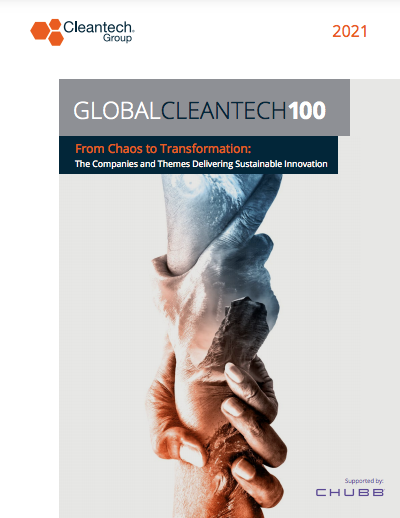Cleantech Research Agenda Update – Q1 2021
Cleantech Group’s research agenda focuses on growth opportunities powered by innovation. From trends and companies to the people and ideas defining the future of industry, we are tracking and engaging with thousands of start-up companies who are shaping a more digitized, de-carbonized and resource-efficient future.
Our analyst team delivers insights on sectors and investment trends allowing our clients to evaluate market attractiveness, business models and competitiveness. We conduct hundreds of research interviews every year across our ecosystem of entrepreneurs, investors, corporations and governments in order to develop a deep expertise in technology and innovation trends.
Here are some highlights from the great stuff we’ve recently published:
- Agriculture & Food: Robotics & Automation:
Enabling technologies are converging to deliver results greater than the sum of their parts and farming is seeing significant change. What is clear is that agriculture is one of the last industries to digitize, and thus, one of the last to reap the benefits of many of these technologies. The widespread use of Artificial Intelligence (AI) in broad acre arable farming will be the most significant transformation to the arable industry since the adoption of the tractor. The increasing importance of biotechnology in agriculture, from the increased testing and trialing times afforded by computational biology to the toolbox available in synthetic biology, is giving rise to business models delivering entirely new food ingredients and agricultural inputs as-a-service. In this Sector Insight, we look at some of the trends driving automation of the farm, and the applications of biotechnology in food and agriculture.

- Distributed Energy Flexibility: Integration, Aggregation & Marketplaces:
As renewable energy power continues to proliferate, localized flexibility at both supply and demand is becoming instrumental. To effectively manage large-scale renewable penetration, flexibility must be harnessed in all sectors of the energy system, from power generation to transmission and distribution systems, storage, and, increasingly, flexible demand. This sector insight explores the role of innovation for distributed energy flexibility, highlighting the role of DER integration, residential aggregation, and flexibility marketplaces. The report also covers corporate investment and acquisition trends, breaking down the value that exists for market stakeholders going into the next decade
Digital Energy Flexibility: Value Chain

2021 Global Cleantech 100:

2021 marks the 12th year of the Global Cleantech 100, our list of the innovative companies poised to take us beyond chaos to the transformation we are all searching for. On the list, you’ll find the most promising ideas in cleantech – the ones best positioned to help us build a more digitized, de-carbonized and resource-efficient industrial future.
In Q1 2021, we are working on these great topics:
Agriculture & Food
![]() Consumer Food Sourcing – This edition of CTG Insight will look at business model and technology innovation that is enabling new sales channels for food as consumers increasingly buy food that is local, fresh, and delivery-only. Covid-19 has accelerated a number of trends in agriculture and food, but adoption of online grocery and delivery services is one of the most significant with broad impacts on food supply chains.
Consumer Food Sourcing – This edition of CTG Insight will look at business model and technology innovation that is enabling new sales channels for food as consumers increasingly buy food that is local, fresh, and delivery-only. Covid-19 has accelerated a number of trends in agriculture and food, but adoption of online grocery and delivery services is one of the most significant with broad impacts on food supply chains.
Energy & Power
Hydrogen – The 2020s is widely being regarded as the decade of the energy molecule. At the heart of this conversation low carbon hydrogen has a vital role to play. In this sector insights we will be exploring the role of innovation in this growing market, and will highlight key areas of innovation across the value chain which are poised to play a large role in the coming years.
Materials & Chemicals
Battery Chemistry – Batteries are increasingly deployed in cleantech applications, from transportation to stationary storage. This places an incredible demand for critical raw materials including lithium and nickel. This insight will look at different battery chemistries, their material needs and how these materials are refined and optimized.
Resources & Environment
Recycling Collection and Sorting Infrastructure – Due to Extended Producer Responsibility policies, consumer and market pressure as well as increasing and diversified waste streams Governments and industry are promoting recycling like never before. FMCG and plastic companies are redesigning products for recycling, while buying more recycled materials as a feed stock. However, the infrastructure surrounding the collection and sorting of waste is inefficient and wasteful, with ~45 % of recycled materials rejected and landfilled. This insight explores the technologies seeking to create a robust market for recycling and improve the economics of domestic recycling, including automated sorting sensors and robotics and digitizing platforms to formalize informal waste collection in developing nations.
Transportation & Logistics
![]()
EV Battery Recycling – Substantial strides in EV Battery recycling are expected as new proposed regulations are going to help drive the proposed Circular Economy Action Plan. Additionally, many automakers have made significant announcements regarding end-of-life pathways for their batteries. In light of these developments, this up-coming analysis will dig deeper into the innovations necessary to reach circularity at scale.


